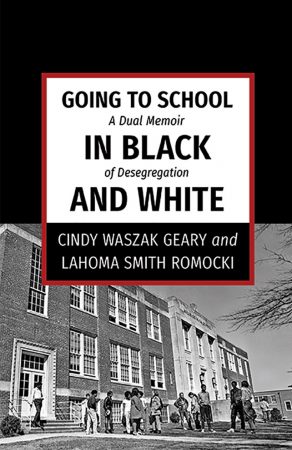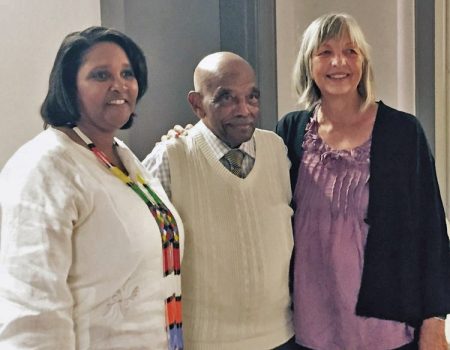
The authors, LaHoma Smith Romocki and Cindy Waszak Geary, pose for a selfie outside the WUNC studio in Chapel Hill last December, before their interview with Frank Stasio, the host of "The State of Things" at North Carolina’s Public Radio. (Photo courtesy of Cindy Waszak Geary)
Among laughter, letters and many cups of coffee at a Durham bakery four years ago, Cindy Waszak Geary mentioned to her writing group that she graduated from Hillside High School.
“First, I didn’t believe her,” LaHoma Smith Romocki said. “I had to give her a test — ‘Do you remember this? Do you remember that? Did you ever meet these people?’ And she passed the test.”

The cover of “Going to School in Black and White: a dual memoir of desegregation”, a book co-authored by two women — one black and the other one white — about their experiences during desegregation in Durham in the 1970s. They both attended Hillside High School during the same time, but formally met each other 40 years later. (Photo courtesy of the authors)
Although they both attended Hillside at the same time, they didn’t realize that until a writing group meeting 40 years later.
In September 2017, the two women published a dual memoir, “Going to School in Black and White: a dual memoir of desegregation,” that explores their life experiences from Waszak Geary’s perspective as a white student and Smith Romocki’s perspective as a black student at Hillside High School in the early 1970s.
At the time, schools in Durham were abruptly desegregated. Waszak Geary began her sophomore year at Hillside, an all-black school, after receiving a letter in the mail demanding that she transfers there. Waszak Geary graduated from Hillside in 1973, while Smith Romocki graduated in 1975.
According to U.S. News & World Report, non-white students make up 98 percent of Hillside High School today. In contrast, minorities make up about half of the student body on average in North Carolina public schools, according to data from the State Board of Education.
“I guess the other reason why we were so moved to talk about our experience at Hillside was tied to what happen to this experiment of integration,” Smith Romocki said. “How could we, 40 years later, be moving in opposite direction of what the civil rights movement had taught us about?”
The authors agreed that their motivations to attend a writing group three years ago were too different to predict they would end up writing a book together.
Smith Romocki, who teaches in North Carolina Central University’s Department of Public Health, was in the process of writing an academic paper about why African-Americans donate blood at lower levels than other Americans. Waszak Geary was exploring creative nonfiction writing for the first time, while working as a private consultant for public health organizations.
After Waszak Geary’s revelation to the group, the idea for the book grew organically.
“When we first started doing this, LaHoma came out with a list of things we wanted to hear each other talk about,” Waszak Geary said. “And we wrote about that, and then we’d give each other what we had written. This was even before we decided to write a book together.”
That’s how the writing process went down — with weekend retreats and third-party critics in the middle.

Authors LaHoma Smith Romocki and Cindy Waszak Geary pose with John Harding Lucas, who served as the principal of Hillside High School while the authors attended school, at the launch of “Going to School in Black and White: a dual memoir of desegregation” in September. (Photo courtesy of Ronald Geary)
“When you have two highly motivated and goal-oriented people, that makes it very easy,” Smith Ramocki said. “The motivation and the enthusiasm was the same.”
The authors have made several appearances at churches, bookstores and reading groups since the memoir was launched last year.
Jane Brown, a former professor at the School of Media and Journalism at The University of North Carolina at Chapel Hill who led the writing group, described the book as thought-provoking.
“I think this experiences made them lifelong friends,” said Brown, who met the authors at UNC-CH, where they completed their graduate studies. “Part of the beauty of the book is how, especially at the end, [the authors] talk about what they had to do to be able to talk about race with each other.”
Smith Romocki said they ultimately hope their stories can provide a safe space for readers wanting to discuss race in America and their own personal encounters with race issues.
“Even seemingly benign compared to some of the things that are going on now, the book might be a place for people to start and to open up about their own feelings and what could change,” Waszak Geary said.
The authors enjoy talking to groups about their memoir. To contact them, email hello@goingtoschoolinblackandwhite.com
For a printer-friendly version of this story, click here.